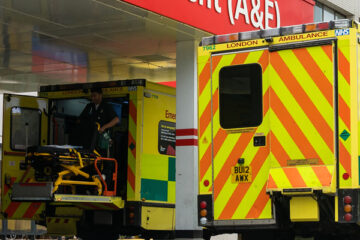Emergency crowding in EDs – why our new guidance is so important

RCEM Vice-President, Ian ‘Higgi’ Higginson, who has led the project, gives his thoughts on why this is so important…
Emergency Department (ED) crowding represents the greatest threat to the timely delivery of emergency care in the UK and across the world. It is present to a greater or lesser extent in many healthcare systems. Although not a new phenomenon, it has been steadily worsening over time. But this does not make it inevitable.
Causes of crowding are complex and can vary between different health systems, hospitals, and over different time periods.
To help support you, the College has produced new crowding guidance, (replacing a 2015 version) with the aim to help in the understanding of the causes and effects of crowding and to provide options for health systems.
What’s the point of the new crowding guidance?
The answers to crowding lie in health policy. Ultimately this sits with politicians in our four nations, and with national health service leaders. Their collective failure to acknowledge what they must surely know, and to offer both the vision and prioritisation of investment that is needed, is disappointing and at times difficult to understand.
This problem is in right in front of us and affects tens of thousands of staff and patients, every day. Fiddling around at the edges with short-term plans and cash injections, both designed – a cynic might argue – to take heat out of the headlines rather than out of our EDs, doesn’t cut it.
Although it is not a policy document and is primarily designed to support those who are trying to manage the problem closer to the coal face, we hope that this guidance adds to the influencing picture.
So, what’s new?
The guidance is contextualised for the current picture rather than that of nearly a decade ago.
It’s also the first time that the traditional Asplin input-throughput-output model has been reversed, attempting to get things in the right order of priority. And it deals with a number of controversies.
Is it crowding or overcrowding?
The literature in the field uses the term ‘crowding’ but we tend to use the word ‘overcrowding’ when we are in the media; much as we use the term ‘A&E’ in our press releases (as that is what the public and media understand), even though many of us fought for years to have our modern specialty name recognised!
Isn’t crowding inevitable?
No. That’s what is so frustrating. I can remember getting cross when patients were in the corridor of my ED, back in the days when we could achieve the four-hour standard and we weren’t always crowded. Although COVID was awful, during the first waves many of us did get to practice EM in departments that flowed.
As a College, we were even talking about taking the chance to ‘re-set emergency care.’ The same thing happened during the first doctors’ strikes. If there is enough capacity to meet demand in our EDs, and we have flow out, everything changes – then we can still practice our beautiful speciality well and offer proper emergency care. When that happens, you can feel the positive vibes in the team.
Personally, I will not accept normalisation of this awful phenomenon. Although it is a truly complex problem and there isn’t a magic wand, it genuinely doesn’t have to be like this.
Should we be releasing guidance covering unacceptable things like corridor care, and looking after patients in ambulances?
This was a topic of considerable debate. We decided that we couldn’t bury our heads in the sand and refuse to talk about mitigation, but we have made clear that we are doing so because we believe we must, to support our members and patients. This does not imply normalisation.
Why do we ‘cautiously support’ boarding on wards?
Boarding potentially achieves a number of aims:
(1) It decompresses EDs,
(2) It spreads risk and pressure more evenly across an organisation,
(3) It may support inpatient teams to improve processes and priorities.
It should not, however, become business as usual.
It should be an escalation measure, alone or as part of ‘full capacity protocols.’ For instance, if boarding is established as an operational norm, where next?
Also, patients boarding on wards should not be seeing the same tumbleweed drift down their corridors during escalation, as we see in ours.
Escalation plans must change things, and work when they are needed (including evenings, nights, and weekends). We only ‘cautiously’ support boarding because there isn’t enough evidence to show it reduces harm and works in the long term.
Why do we ‘cautiously support’ continuous flow protocols?
Similar answer. It’s easy to get these confused with full capacity protocols: continuous flow models are a more proactive approach… redesigning the ways hospitals work around predictable flow, rather than allowing things to build up before acting.
What don’t we get behind ambulance diversion?
Ambulance diversion seems to be the next big thing. In practice it can distract from solving the underlying issues or prevent organisations looking to themselves whilst they are busy trying to send their work elsewhere.
It’s one thing in urban areas, quite another in more rural settings. It may have a purpose as part of escalation, but not as business as usual.
Why do we talk about ‘throughput’ interventions when ‘output’ is king?
Many throughput interventions lie at the core of how EDs are resourced and run – and are needed to reduce the risk from crowding. Some wouldn’t be necessary, and many would need less resource, if our EDs were not crowded.
It also helps people understand that improving throughput isn’t about beating up ED teams to try to work harder and faster.
Why do we talk about ‘input’ interventions if we don’t think they are the priority?
Partly to emphasise that they shouldn’t be the focus, or a distraction, partly so we can offer an opinion on how they could be improved, and partly because whilst they may not impact significantly on the harm associated with crowding, they may improve quality of care in other ways.
Why do we still include the four-hour standard in our recommendations?
Partly because it is still a widely understood national standard, partly to emphasise that it needs to be set at the right level (and not 76%), and partly because until there is a better alternative, it’s the best we’ve got.
Why talk about 12 hours?
To make sure that patients who remain in EDs beyond four hours aren’t ignored for data purposes, which may lead to ‘gaming.’ Sadly, the spectre of putting standards before patients still hangs over us, and we try to call it out when we see it. The sad truth is that we have moved to a place where we must advocate for patients who have been with us for unacceptably long times and keep reminding NHS leaders that this isn’t about optics but is about people. And then we come back to the failures I described from my soap box earlier. I’ll stop before I get back on it…
The new crowding guidance has been a huge issue to tackle and been a beast to write but can still be revised as required, so is not set in stone. I must thank Ed Smith for the hard yards he put in. We wanted the guidance to be short enough to read, yet sufficiently granular to be useful. We hope we have got the balance right and that it is a positive contribution. Let us know if you think we’ve missed anything important (or if it proves useful).
Take care of yourselves.
Higgi



0 Comments